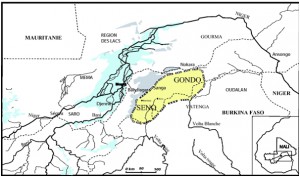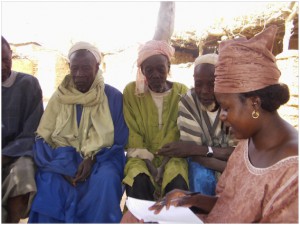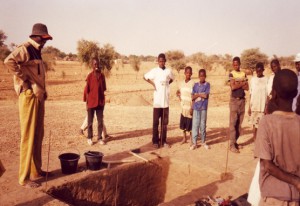Settlement history has always been a major challenge for the reconstruction of cultural, social and even “ethnic” identities. As a crossroads, the Séno-Gondo Plain is an ideal region to develop such a reconstruction of settlement history. Located in the Dogon Country, it is known for its wealth of oral traditions that have been passed on from generation to generation.
The aim of our study was to determine the settlement context of the Séno-Gondo Plain and to establish its chronological framework. Were there settlements prior to the arrival of the Dogon? If so, who were these populations?
To accomplish this work, a multidisciplinary study was conducted. First, we carried out surveys of oral traditions in order to reconstruct the settlement history. Alongside the transcription of oral tradition, we also carried out archaeological field survey and test excavations to identify the material elements associated with the early settlement history of the region.
Ethnohistorical approach
A detailed analysis of the traditions revealed a history of Dogon migration much more complex and earlier than initially assumed. Much of the population placed the Dogon migration under the Mali Empire, but a minority is said to have come from elsewhere. Based on the descendants of Onronton (Ono), they came from a distant country. Based on the descriptions of A. Guindo de Béréli (December 2007), their ancestors fled from enemies on horseback who wanted to convert them to a new religion and from a severe drought in their region of origin. Before the arrival of the new religion, the inhabitants of this country worshiped a great serpent. This account retells exactly what some authors have written about the decline of the Ghana Empire at the end of the 11th century AD (1076).
Regardless of the reason for their flight, the modern Dogon retained the different steps of their migration. While populations coming from the Mandé appear to be dominant, others say that they do not come from this region. Their account rather links them to the ancient Ghana Empire. The idea of a massive and single arrival of the Dogon during the 15th century is further challenged by several recent studies, including our own.
Despite such wealth of data, retracing the stages of Dogon settlement on the Séno-Gondo Plain using oral traditions alone is difficult, information for some zones remaining quite confused. Recourse to an archaeological approach is therefore needed to overcome uncertainties and meet our objectives, which are to establish the origin and processes of settlement of the major families on the Séno-Gondo Plain, the chronology of their arrival in the region and their roles and status within Dogon society.
Archaeological approach
The characteristics of the ceramics recovered during test excavations at three different sites (Damassogou, Nin-Bèrè1 and Ambéré-Dougon) show the coexistence of several traditions over a long chronological period of time (between the 2nd and the 14th centuries AD). The Dogon thus cohabited with other populations after their arrival. We thus support the hypothesis that the Dogon Country was a privileged place for interactions between many heterogeneous populations which, with time, led to the creation of what is called today the “Dogon people”.
Our excavations have also identified a previously unknown ceramic decoration that we have termed “Béréli braided cord roulette impression”. At present, this decoration, also found in the site of Sadia, cannot be strictly associated with a cultural group. Our archaeological research indicates that the Séno-Gondo Plain was occupied prior to the arrival of the Dogon by different populations, grouped under the term “pre-Dogon”.
Scenario
The ethnohistorical and archaeological data now enable the development of several hypotheses regarding the settlement of the Séno-Gondo Plain and construction of a settlement scenario.
Prior to the presumed arrival of the Dogon, commonly associated with the interval between the 13th and the 15th centuries AD, the Séno-Gondo Plain was first occupied between the 2nd and the 9th centuries AD by pre-Dogon populations to which some no longer existing ceramic decoration can be attributed.
Between the 9th and the 15th centuries AD, the Séno-Gondo Plain underwent at least four successive migration waves. The first probably took place after the peak of the Ghana Empire. The second seems to have come from the Mali Empire after the pilgrimage of Kankou Moussa to Mecca (1324). The third probably resulted from the retreat from the northern Dogon Country of populations fleeing the Songhay Empire. The fourth wave came from the Mossi following pressure exerted by the Mossi Naaba.
From the 16th to the 19th centuries, many conquerors captured slaves on the Séno-Gondo Plain, including the Tuareg, the Mossi, the Ségou from Bambara and the Peul from Macina. The Séno-Gondo Plain seems to have been nearly entirely abandoned during this period.
In the 19th and 20th centuries, the Séno-Gondo Plain became safer and inhabitants began to reoccupy formerly occupied villages. However, this dynamic of return was hampered by French colonization. This new conquest remains a painful memory for most of the population in the region, which saw able-bodied men leave the region, requisitioned for the war front or conscripted for large work sites. At the end of this period, stability returned and the population on the plain nearly doubled.
The combined analysis of data from ethnohistorical survey and archaeological excavations has thus proven to be pertinent for this kind of research. We can confirm that settlement of the plain is the result of multiple occupation episodes by populations of different origins.
Néma Guindo



